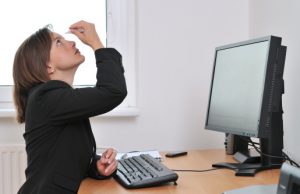
By Scott Thomas
Eye strain
Eye strain (or computer vision syndrome) has been a consistent issue in my year plus of operating an eye gaze computer. It is common among computer users, and a compounding issue if you are someone who relies on their eyes for productivity and communication. Discomfort due to eye strain increases as users spend more time behind the screen, so, what can we do to lessen our discomfort? Having a well-lit environment is a good first step.
Bright lights from natural or artificial light are a common contributor to eye strain. Scrap fluorescent lighting, and r turn down or eliminate the artificial lighting in your work space. If overhead lighting is too bright, consider lamps that produce a dimmer light.
Consider the Glare
Natural light coming in from windows causes my eyes the most distress. Eye gaze computer systems won’t recognize the eyes if there is an excessive amount of glare. Consider that darker wall paint doesn’t reflect natural light like white or light coloring. Blinds and adding curtains can also aid in eliminating too much natural light that causes excessive glare. Once you get your space set with the right amount of lighting for your comfort set your computer screen brightness to match the rooms brightness, as closely as possible.
Glare in the winter months is especially problematic due to the sun’s rays redirecting off fallen snow. I purchased an inexpensive pair of glasses intended to reduce eye strain by filtering certain harmful forms of computer produced light, and by reducing glare. In a way, they are sunglasses for the indoors, without the dark tint. You can also have your prescription glasses tinted for computer usage. I don’t know if they filter certain rays, but they do reduce glare. When wearing them the computer screen glare is less and the glare from the natural light entering from the windows is diminished.
Dry Eyes
Dry eyes are another symptom of computer vision syndrome. Optometrists recommend steering clear of products like Visine and recommend eye lubricants. Fish oil may support the eye’s ability to create natural lubrication. Ask your optometrist what they suggest during your next exam.
Additionally, increasing your text size and contrast can reduce stress on your eyes.

Blink and Break
The previous recommendations are all helpful tips to set yourself up for success, but the real results come from the following disciplined practices. Blink often – blinking naturally lubricates the eyes andwe have a tendency to blink less when staring at a screen.
Take a break from the screen and follow the 20-20-20 rule. Every 20 minutes or as often as you can remember, stare at an object 20 feet away for 20 seconds. This helps to relax and refocus our eyes. If you are like me, and not disciplined enough to take a break every 20 minutes, look away from your computer every few minutes and focus on an object for a couple of seconds. There are many combinations of focusing exercises you can find in a quick Google search. I feel the greatest relief by focusing on an object 20 feet away for 20 seconds, then focusing on an object 5 feet away for 15 seconds. I’ve found that taking a break from the screen for a few minutes after completing an exercise helps my eyes feel the most refreshed.
Whether playing video games or using a phone, tablet or computer, using these tips and remaining consistent in the exercises will help keep your eyes protected from uncomfortable eye strain.
